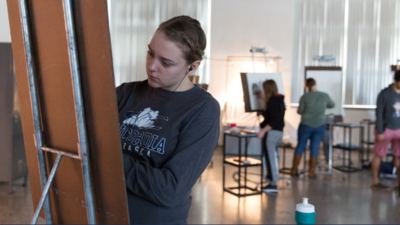What Is Art Therapy?

Making art is a creative approach to engaging one’s mind, expressing feelings and connecting thoughts in new ways. It can help calm the senses, imagine new possibilities, and look at life from a different perspective. Art therapy, therefore, is a unique psychotherapeutic method that makes use of these qualities of art in the treatment and management of mental health challenges. At Concordia University, Nebraska, you can earn a Bachelor of Arts degree in this practice, preparing you for graduate school and an eventual career in art therapy.
Art therapists are not traditional mental health therapists; nor are they art educators or purely artists. They are knowledgeable in the study of art and psychology. Art therapists are unique mental health and human services workers who receive specialized training in the practice of teaching clients to engage their minds and bodies in ways that are impossible with just verbal articulation. The legitimate practice of art therapy requires a master’s degree in the field, as well as licensure – for which requirements vary by state.
Art therapy – or the practice of using art as a tool for clients’ emotional expression – began in the early twentieth century with Margaret Naumburg, a specialist in child education and psychoanalysis. Naumburg is credited with being the first practitioner to utilize art therapy in the treatment and diagnosis of mental health conditions. She set forth the first guidelines for the use of artistic creation in managing and expressing clients’ inner emotional lives.
In an art therapy session, clients may draw, paint, sculpt with clay, create collages or use any other type of creative technique with the goal of working through emotional or physical challenges. Different populations may take part in art therapy to achieve specific outcomes. For example, some art therapists work with physically disabled populations to improve dexterity or range of motion. Additionally, many work with children – particularly children who have experienced trauma, juvenile criminal convictions or are disabled—to improve their emotional regulation and expression.
Art therapy does not require its clients to be “good” at art, only open to the concept of using art as a nonverbal method of self-disclosure. Therefore, art therapists can find employment in a wide range of settings serving many populations. Hospitals, schools, veterans’ clinics, private practices, and psychiatric care facilities are only some of the places where art therapists may spend their career. They can work with veterans, the elderly, children, people with a specific mental health condition, or the physically disabled.
Often, art therapists work as part of a larger mental health care team in the treatment of patients. These teams may include psychologists, psychiatrists, social workers, and more. These teams collaborate in the determination of best practices to be used for a specific person’s treatment plan. All members understand basic psychological theory and the use of therapeutic techniques – art therapists included, since their undergraduate education must include several psychology-related courses.
The art created by clients in therapy sessions can be used as a nonverbal method of telling a story from one’s life or revealing their emotions about an issue; in other cases, it can be used in conjunction with verbal descriptions of life events and feelings. Either way, art therapists may use sessions to gain knowledge about and interpret the content of clients’ inner lives. The process of creating art may allow clients to calm down from an intense emotional state, causing them to consider their situation more rationally; it may alternatively cause them to experience and describe emotions that they have previously found it difficult to articulate.
The rewards of a career in art therapy are plentiful. Gaining the knowledge and skills required to work with clients in a way that may cause them to engage with the world in a unique manner joins the tangible evidence of the progress represented in their art across sessions. Therapists can witness clients’ breakthroughs and participate in their healing process, no matter the type of challenges they are facing.
Art therapy is a distinctive type of mental health treatment that allows clients the chance to express their emotions in a way that other forms of therapy do not. Art therapists, therefore, are privileged professionals who, at Concordia University, Nebraska’s art therapy program, can prepare to take part in this process.
Interested in Concordia’s art therapy program? Learn more here.
Related Stories


